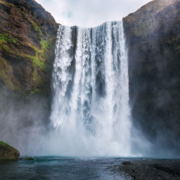Waterfall Photography Debate: Fast vs. Slow Shutter Speeds
Waterfall photography is a genre that captivates many with its ethereal beauty and dynamic compositions. One of the age-old debates within this realm is whether to use fast or slow shutter speeds when capturing waterfalls. Both approaches have their merits and can produce breathtaking results. Here, we’ll dive deep into the argument, exploring the advantages and disadvantages of each method.
1. Fast Shutter Speeds: Freezing the Action
Using a fast shutter speed means that the camera’s sensor is exposed to light for a very brief period.

Advantages:
- Detail Capture: A fast shutter can freeze every droplet, allowing for a detailed capture of the water’s texture and movement.
- Reality Reflection: This method offers a more “realistic” portrayal of the scene as our eyes see it.
- Safety: In certain lighting conditions, a fast shutter speed might prevent overexposure.
Disadvantages:
- Potential for Flatness: If not executed well, the photograph can feel lifeless or static, lacking the inherent motion and energy of a waterfall.
- Higher ISO Requirement: To compensate for the reduced light from the quick shutter, you might need to increase the ISO, which could introduce noise to the photo.
2. Slow Shutter Speeds: Creating a Silky Effect
When photographers use slow shutter speeds for waterfalls, the camera sensor is exposed to light for an extended period, often necessitating the use of a tripod to prevent camera shake.

Advantages:
- Ethereal Feel: The prolonged exposure creates a milky or silky effect in the moving water, often evoking a dreamy, surreal atmosphere.
- Enhanced Mood: This method can amplify the mood, whether it’s tranquil, majestic, or mysterious.
- Low ISO: With a slower shutter, there’s more light hitting the sensor, allowing photographers to use a lower ISO, potentially yielding cleaner shots.
Disadvantages:
- Loss of Texture: The slow shutter speed might smooth out interesting textures and details in the water.
- Risk of Overexposure: Especially in bright conditions, there’s a risk of overexposing parts of the photo, which can lose details in the highlights.
- Need for Stability: Achieving a sharp photo with a slow shutter speed almost always requires a tripod or stabilizing equipment.
Striking a Balance:
Instead of staunchly adhering to one method, many photographers adopt a balanced approach. Here are some tips:
- Evaluate the Scene: The nature of the waterfall, its surroundings, and the lighting conditions should guide your decision.
- Bracketing: Try capturing multiple shots at varying shutter speeds and choose the best later or blend them in post-production.
- Use ND Filters: Neutral Density (ND) filters allow for slower shutter speeds even in bright conditions by reducing the amount of light entering the lens.
Conclusion:
While the debate between fast and slow shutter speeds for waterfall photography continues, what’s undeniable is the beauty of the subject. Both methods have their place, and the choice often comes down to personal preference and the story one wishes to convey. Whether you’re a fan of the crisp clarity of fast shutter speeds or the dreamlike quality of slow ones, mastering both techniques will only enhance your versatility and creativity as a photographer.





